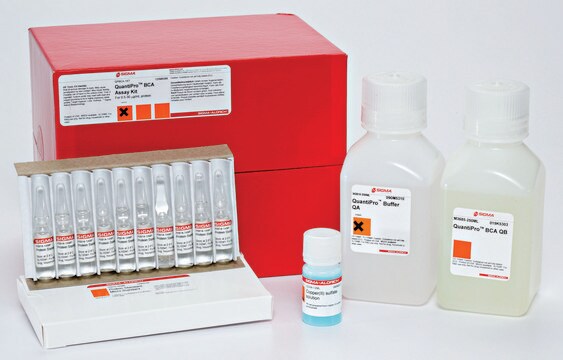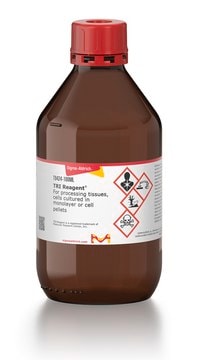R1137
Hind III from Haemophilus influenzae
Restriction Enzyme
Faça loginpara ver os preços organizacionais e de contrato
About This Item
Número CAS:
Número MDL:
Código UNSPSC:
12352204
Produtos recomendados
grau
for molecular biology
forma
buffered aqueous glycerol solution
concentração
≥10000 units/mL
10,000 units/mL
Condições de expedição
wet ice
temperatura de armazenamento
−20°C
Procurando produtos similares? Visita Guia de comparação de produtos
Especificidade
Recognition sequence: 5′-A/AGCTT-3′
Cutting results: 2-10-fold Hind III overdigestion of 1 μg λ DNA substrate results in 100% cutting
Heat inactivation: 65 °C for 15 minutes
Cutting results: 2-10-fold Hind III overdigestion of 1 μg λ DNA substrate results in 100% cutting
Heat inactivation: 65 °C for 15 minutes
Aplicação
HindIII, a restriction endonuclease, is used in molecular biology applications to cleave DNA at the recognition site 5′-A/AGCTT-3′ to generate DNA fragments with cohesive 5′-ends.
Outras notas
Supplied with 10x Restriction Enzyme Buffer SB (B8781)
Comment: Hind III under suboptimal reaction conditions will cleave secondary recognition sites (star activity).
forma física
Solution in 10 mM Tris-HCl, pH 7.5, 0.1 mM EDTA, 1 mM dithioerythritol, 250 mM NaCl, 0.01% polydocanol (v/v), 50% glycerol (v/v) at 4 °C
produto relacionado
tampão de incubação
Nº do produto
Descrição
Preços
Código de classe de armazenamento
12 - Non Combustible Liquids
Classe de risco de água (WGK)
WGK 1
Ponto de fulgor (°F)
Not applicable
Ponto de fulgor (°C)
Not applicable
Certificados de análise (COA)
Busque Certificados de análise (COA) digitando o Número do Lote do produto. Os números de lote e remessa podem ser encontrados no rótulo de um produto após a palavra “Lot” ou “Batch”.
Já possui este produto?
Encontre a documentação dos produtos que você adquiriu recentemente na biblioteca de documentos.
Stephen J King et al.
Molecular biology of the cell, 14(12), 5089-5097 (2003-10-21)
Cytoplasmic dynein and dynactin are megadalton-sized multisubunit molecules that function together as a cytoskeletal motor. In the present study, we explore the mechanism of dynein-dynactin binding in vitro and then extend our findings to an in vivo context. Solution binding
M Hsu et al.
Biochemistry, 17(1), 131-138 (1978-01-10)
In the presence of 100 mM Tris buffer (pH 7.5) and 1-10 mM Mg2+ EcoRI endonuclease cleaves DNA at a specific nucleotide sequence and in a characteristic way: -GAATTC-. But if Mg2+ is replaced by Mn2+, the specificity of the
Tomás Brdicka et al.
The Journal of experimental medicine, 196(12), 1617-1626 (2002-12-18)
A key molecule necessary for activation of T lymphocytes through their antigen-specific T cell receptor (TCR) is the transmembrane adaptor protein LAT (linker for activation of T cells). Upon TCR engagement, LAT becomes rapidly tyrosine phosphorylated and then serves as
C Kessler et al.
Gene, 92(1-2), 1-248 (1990-08-16)
The properties and sources of all known class-I, class-II and class-III restriction endonucleases (ENases) and DNA modification methyltransferases (MTases) are listed and newly subclassified according to their sequence specificity. In addition, the enzymes are distinguished in a novel manner according
Cong Zhu et al.
Nucleic acids research, 41(4), 2455-2465 (2013-01-11)
Zinc-finger nucleases (ZFNs) have been used for genome engineering in a wide variety of organisms; however, it remains challenging to design effective ZFNs for many genomic sequences using publicly available zinc-finger modules. This limitation is in part because of potential
Nossa equipe de cientistas tem experiência em todas as áreas de pesquisa, incluindo Life Sciences, ciência de materiais, síntese química, cromatografia, química analítica e muitas outras.
Entre em contato com a assistência técnica







